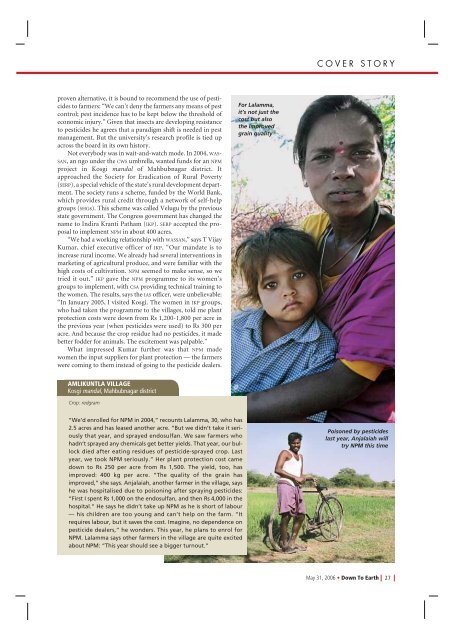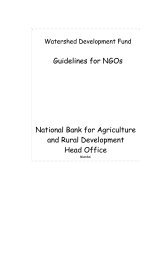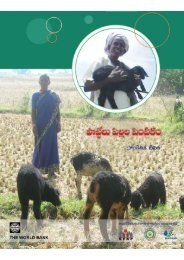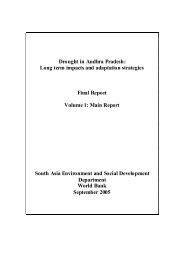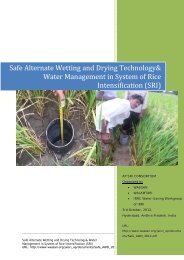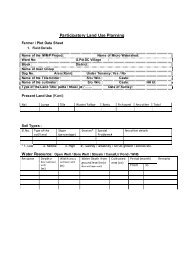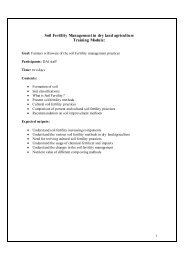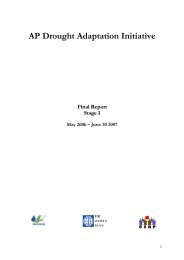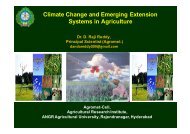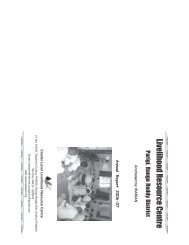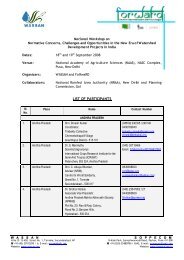OUT OF THE TRAP - Centre for Sustainable Agriculture
OUT OF THE TRAP - Centre for Sustainable Agriculture
OUT OF THE TRAP - Centre for Sustainable Agriculture
Create successful ePaper yourself
Turn your PDF publications into a flip-book with our unique Google optimized e-Paper software.
COVER STORYproven alternative, it is bound to recommend the use of pesticidesto farmers: “We can’t deny the farmers any means of pestcontrol; pest incidence has to be kept below the threshold ofeconomic injury.” Given that insects are developing resistanceto pesticides he agrees that a paradigm shift is needed in pestmanagement. But the university’s research profile is tied upacross the board in its own history.Not everybody was in wait-and-watch mode. In 2004, WAS-SAN, an ngo under the CWS umbrella, wanted funds <strong>for</strong> an NPMproject in Kosgi mandal of Mahbubnagar district. Itapproached the Society <strong>for</strong> Eradication of Rural Poverty(SERP), a special vehicle of the state’s rural development department.The society runs a scheme, funded by the World Bank,which provides rural credit through a network of self-helpgroups (SHGs). This scheme was called Velugu by the previousstate government. The Congress government has changed thename to Indira Kranti Patham (IKP). SERP accepted the proposalto implement NPM in about 400 acres.“We had a working relationship with WASSAN,” says T VijayKumar, chief executive officer of IKP. “Our mandate is toincrease rural income. We already had several interventions inmarketing of agricultural produce, and were familiar with thehigh costs of cultivation. NPM seemed to make sense, so wetried it out.” IKP gave the NPM programme to its women’sgroups to implement, with CSA providing technical training tothe women. The results, says the IAS officer, were unbelievable:“In January 2005, I visited Kosgi. The women in IKP groups,who had taken the programme to the villages, told me plantprotection costs were down from Rs 1,200-1,800 per acre inthe previous year (when pesticides were used) to Rs 300 peracre. And because the crop residue had no pesticides, it madebetter fodder <strong>for</strong> animals. The excitement was palpable.”What impressed Kumar further was that NPM madewomen the input suppliers <strong>for</strong> plant protection — the farmerswere coming to them instead of going to the pesticide dealers.For Lalamma,it’s not just thecost but alsothe improvedgrain qualityAMLIKUNTLA VILLAGEKosgi mandal, Mahbubnagar districtCrop: redgram“We’d enrolled <strong>for</strong> NPM in 2004,” recounts Lalamma, 30, who has2.5 acres and has leased another acre. “But we didn’t take it seriouslythat year, and sprayed endosulfan. We saw farmers whohadn’t sprayed any chemicals get better yields. That year, our bullockdied after eating residues of pesticide-sprayed crop. Lastyear, we took NPM seriously.” Her plant protection cost camedown to Rs 250 per acre from Rs 1,500. The yield, too, hasimproved: 400 kg per acre. “The quality of the grain hasimproved,” she says. Anjalaiah, another farmer in the village, sayshe was hospitalised due to poisoning after spraying pesticides:“First I spent Rs 1,000 on the endosulfan, and then Rs 4,000 in thehospital.” He says he didn’t take up NPM as he is short of labour— his children are too young and can’t help on the farm. “Itrequires labour, but it saves the cost. Imagine, no dependence onpesticide dealers,” he wonders. This year, he plans to enrol <strong>for</strong>NPM. Lalamma says other farmers in the village are quite excitedabout NPM: “This year should see a bigger turnout.”Poisoned by pesticideslast year, Anjalaiah willtry NPM this timeMay 31, 2006 • Down To Earth27


